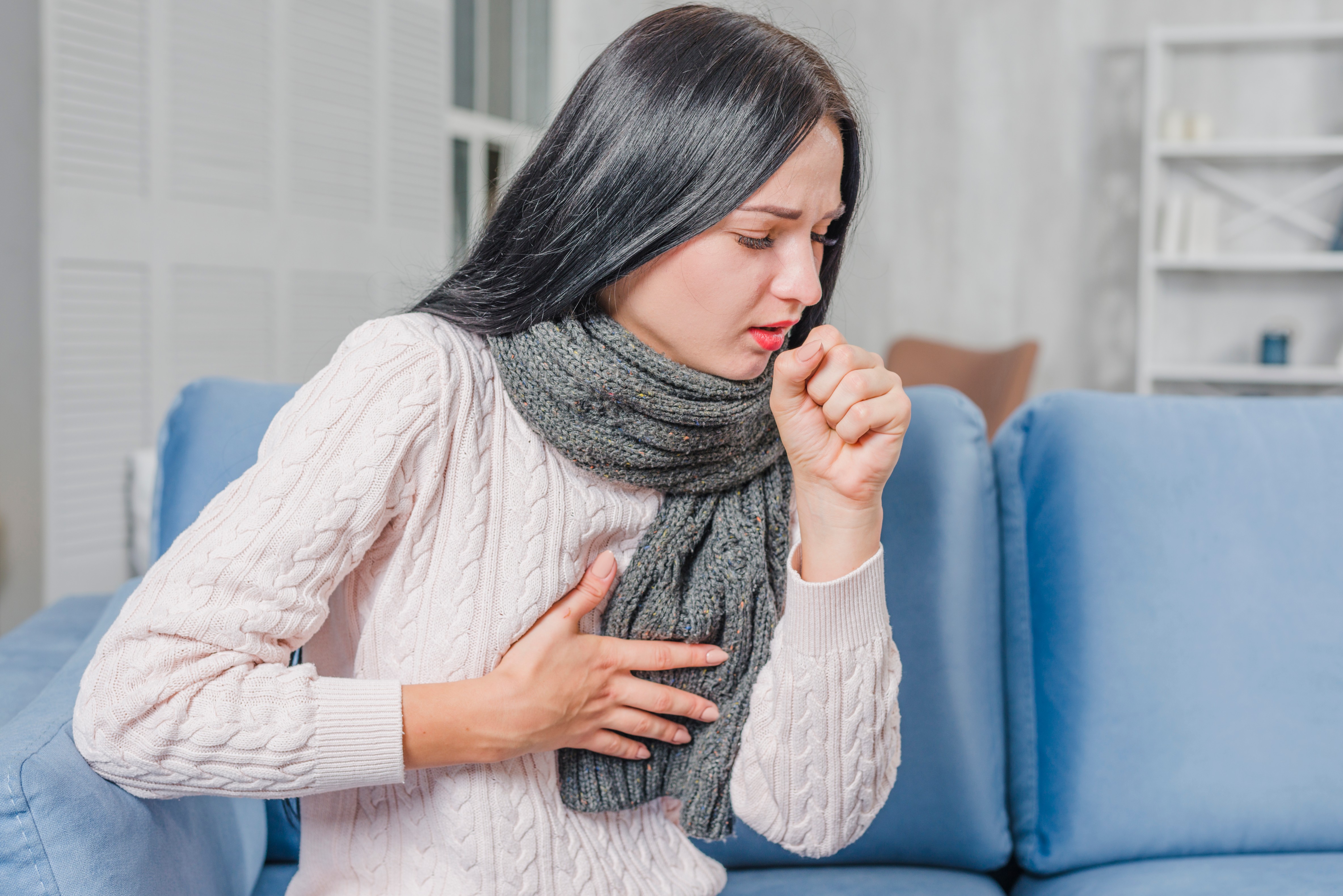General Health | 9 min read
Pneumonia: Symptoms, Causes, Types and Treatment
Medically reviewed by
Table of Content
Key Takeaways
- The highly dangerous infection of pneumonia damages the lungs by causing them to fill with fluid or pus
- The type of organism—bacteria, virus, or fungus infecting the lungs determines the causes of pneumonia
- The symptoms of pneumonia and the common cold are similar enough to be frequently confused
Pneumonia is a highly contagious illness, but the risk of getting it can be lessened with vaccinations, respiratory hygiene, and the right information. It affects the lungs by causing them to fill with fluid or pus. As a result, the afflicted person finds it harder to breathe in the necessary oxygen for the body.
Causes of Pneumonia
Pneumonia causes are based on the type of organism that infects the lungs: bacteria, virus, or fungus.
Fungal Pneumonia
Commonly caused by the fungus in bird droppings or from the soil, such an infection primarily affects those with suppressed or weakened immune systems. The types of fungi that cause it are Histoplasmosis species, Pneumocystis jirovecii, and Cryptococcus species.
Viral Pneumonia
Among the milder forms of this disease, viral pneumonia can be treated at home and one can recover within a few weeks, generally one to three. There are a few common viruses that may cause pneumonia, namely, rhinoviruses, influenza, and respiratory syncytial virus.
Bacterial Pneumonia
In this case, the bacteria travel into the lungs and multiply. Generally, it can occur on its own or as a result of a previous sickness. There are multiple types of bacteria that can cause this, of which the Streptococcus bacteria is the most common.
Types of Pneumonia
There are 4 types of pneumonia, which are as follows:
Hospital-Acquired Pneumonia (HAP):
This particular bacterial pneumonia is obtained while being treated in a hospital. Since the bacteria implicated might be more resistant to medications than other varieties, it could be more dangerous.
Community-Acquired Pneumonia (CAP):
This mentions pneumonia that is developed outside of a hospital or other institutional setting.
Ventilator-Associated Pneumonia (VAP):
VAP is the term used to describe pneumonia in ventilator-dependent patients.
Aspiration Pneumonia:
Aspiration pneumonia is brought on by inhaling bacteria into your lungs through food, drink, or saliva. If you have trouble swallowing or are very sleepy from using narcotics, alcohol, or other sedatives, it's more likely to occur.
Of these types, HAP is among the more serious ones as it may be caused by bacteria resistant to antibiotics. Regardless of the type, it is an illness that shouldn’t be taken lightly. Here’s an overview of the causes, symptoms, complications, and treatment for the disease.
Pneumonia Stages
Depending on which part of the lungs it affects, pneumonia can be categorized as follows:
Bronchopneumonia
The lungs of your body can be affected by bronchopneumonia. It frequently occurs at or around your bronchi. These tubes connect your lungs to your windpipe.
Lobar Pneumonia
One or more of your lungs' lobes are affected by lobar pneumonia. Each lung is made up of lobes, which are separated parts of the lung.
Based on how it has developed, lobar pneumonia can be further split into four stages:
- Congestion: The tissue of the lungs seems heavy and congested. It occurs in the air sacs when a fluid of infectious organisms accumulates
- Red hepatization: Immune and red blood cells enter the fluid, and the lungs take on a red, solid appearance
- Gray hepatization: While immune cells are still present, sometimes red blood cells start to degrade. As a result, they turn their color from red to grey
- Resolution: When the infection is removed by immune cells, it is known as resolution. A successful cough aids in expelling any remaining fluid from the lungs
Pneumonia Symptoms
Pneumonia symptoms are often confused with that of the common cold as they share many commonalities. It can be indicated by other symptoms as well:
- Coughing with mucus
- Chills and sweating
- Breathing difficulty
- Loss of appetite
- Fever, even up to 105°F
- Chest pain
- Nausea
- Headaches
- Bluish lips
- Fatigue and extreme tiredness
Pneumonia Risk Factors
Anyone can acquire pneumonia, but some people are at a higher risk than others. These groups consist of:
- Newborns through 2-year-olds
- People over the age of 65
- Individuals with weaker immune systems because:
- Pregnancy
- HIV
- The use of specific pharmaceuticals, such as steroids or specific cancer treatments
- Individuals with specific chronic medical issues, such as:
- Cystic fibrosis
- Diabetes
- COPD
- Heart disease
- A sickle cell condition
- Liver infection
- Kidney disease
- Individuals who have recently or currently been hospitalized, especially if they have been or are presently using a ventilator
- Individuals who have experienced a neurological condition that may impair the capacity to swallow or cough, including
- Stroke
- A head injury
- Dementia
- Parkinson's condition
- Individuals who have frequently been exposed to lung irritants, including air pollution and hazardous gases, particularly at work
- Individuals who reside in confined quarters, such as in a prison or nursing home
- People who smoke make it more difficult for the body to clear mucus from the lungs
- People who take drugs or consume excessive amounts of alcohol, which weaken the immune system and increase the chances of breathing saliva or vomit into the lungs due to drowsiness
Pneumonia Complications
The disease affects your lungs and can cause respiratory problems. It can worsen pre-existing conditions or cause other health complications if it is left untreated. People with chronic illnesses such as diabetes or weakened immune systems are prone to congestive heart failure or a heart attack. It can lead to serious health complications like:
Lung Abscesses
Pneumonia can cause a bacterial infection in the lungs, which leads to the formation of pus within the cavities of the lungs. This makes it hard to breathe and a common solution is to have it drained before it causes lasting damage. In severe cases, surgery is required to clear the lung cavities.
Pleural Effusion
The pleura are thin membranes that surround or line the chest cavity and lungs. With pneumonia, there is a possibility of fluid build-up in the pleura and this causes chest pain and shortness of breath.
Acute Respiratory Distress Syndrome (ARDS)
ARDS is a very serious and severe lung condition that prevents organs from getting the required amount of oxygen for optimal function. The fluid fills up in the lung’s air sacs. It can cause organ failure at worst and requires immediate medical care.
Bacteraemia
This is a condition in which the bacteria travel into the bloodstream and wreak havoc in the body. Low blood pressure, organ failure, or even septic shock are some of its common complications.
Pneumonia Diagnosis
Your medical history will be examined in the beginning by your doctor. They'll enquire about your general health and the timing of the appearance of your symptoms.
The next step is a physical examination. This will involve using a stethoscope to listen to your lungs for any unusual noises, such as crackling.
Your doctor might also prescribe one or more of the following tests, based on the severity of your symptoms and your risk of complications:
Chest X-ray
An X-ray aids your doctor in searching for indications of chest inflammation. Your doctor can learn more about the location and severity of any inflammation from the X-ray if it is present.
Blood Culture
This test confirms an infection using a blood sample. Additionally, culturing can aid in determining what might be the root of your ailment.
Sputum Culture
A sample of mucus is taken during a sputum culture after you have coughed vigorously. It is subsequently delivered to a lab for analysis in order to determine the infection's origin.
Pulse Oximetry
The amount of oxygen in your blood is measured with pulse oximetry. When a sensor is attached to one of your fingertips, it can tell you whether your bloodstream is receiving enough oxygen from your lungs.
CT Scan
CT scans provide a more accurate and thorough image of your lungs.
Fluid Sample
A fluid sample may be taken with a needle inserted between your ribs if your doctor suspects there is fluid in the pleural space of your chest. This examination might aid in determining the source of your infection.
Bronchoscopy
The lungs' airways are examined during a bronchoscopy. It is done by gently guiding a flexible tube with a camera down your throat and into your lungs.
If your early symptoms are severe or you are hospitalized and do not respond well to antibiotics, your doctor may perform this test.
Treatment for Pneumonia
Your type of pneumonia, its severity, and overall health will all determine your treatment.
Medications on Prescription:
- Your doctor may recommend a medicine to treat your pneumonia. The treatment you receive will depend on the precise cause of your pneumonia.
- Most cases of bacterial pneumonia can be treated with oral antibiotics. Even if you start to feel better, always finish your prescription for antibiotics. Failure to do so could delay the healing of the infection and make future treatments more difficult.
- Viral infections cannot be treated with antibiotics. Your doctor could occasionally recommend an antiviral. With at-home treatment, viral pneumonia cases frequently get better on their own.
Over-the-counter Pharmaceuticals:
- If necessary, your doctor may also advise using over-the-counter (OTC) drugs to treat your discomfort and fever. These may consist of the following:
- Aspirin
- Ibuprofen (Advil, Motrin)
- Acetaminophen (Tylenol)
- Additionally, your doctor can advise cough medicine to lessen your cough so you can get some rest. Remember that coughing aids in the removal of fluid from your lungs, so you don't want to get rid of it completely.
Home Remedies For Pneumonia:
- Even while there are certain things you may do to lessen symptoms, home remedies don't actually treat pneumonia.
- One of the most typical signs of pneumonia is coughing. Salt water gargles and peppermint tea are two natural remedies for coughs.
- The use of cool compresses can help lower a fever. Chills can be relieved by sipping warm water or eating a warm bowl of soup.
- Get enough sleep and drink lots of water to hasten your recovery and avoid a recurrence.
- Although home remedies can lessen symptoms, following your treatment plan is crucial. Follow the directions on any prescription medicine you may be taking.
Hospitalization:
- You might require hospitalization if your symptoms are very severe or if you have additional health issues. Medical professionals can monitor your breathing, temperature, and heart rate in the hospital. Hospital care may consist of:
- Injection of antibiotics into a vein
- To increase your oxygenation, you may benefit from respiratory therapy, which involves administering certain drugs directly into your lungs or learning breathing techniques.
- Oxygen therapy to keep your blood oxygen levels stable (received through a nasal tube, face mask, or ventilator, depending on severity)
Treatment for this disease varies based on the type of pneumonia. For the more serious cases, antibiotic and antifungal medication treats bacterial and fungal pneumonia. Viral pneumonia may be cured with home care. The best approach is to control the fever and relieve pain while the body heals.
In severe cases, treatment relies on hospitalisation and specialised care. Doctors will monitor vitals, administer antibiotics intravenously, or even resort to respiratory or oxygen therapy.
You should prioritise proper medical care even though you can treat the fever and pain with over-the-counter medication. Consult a general physician near you or a doctor who specialises in infectious diseases. To do so stress-free, you can use the healthcare platform provided by Bajaj Finserv Health and simplify the process of availing medical care altogether.
With it, you can find the nearest doctor clinics, book appointments online, and avail of telemedicine services too. What’s more, you also have to option to consult these specialists online via video, thus ensuring you can get diagnosed and treated without the need for a physical visit. It's time to take your health in your hands and begin the journey to a healthy life.
References
- https://www.thelancet.com/journals/langlo/article/PIIS2214-109X(18)30408-X/fulltext
- https://www.webmd.com/lung/understanding-pneumonia-basics
Disclaimer
Please note that this article is solely meant for informational purposes and Bajaj Finserv Health Limited (“BFHL”) does not shoulder any responsibility of the views/advice/information expressed/given by the writer/reviewer/originator. This article should not be considered as a substitute for any medical advice, diagnosis or treatment. Always consult with your trusted physician/qualified healthcare professional to evaluate your medical condition. The above article has been reviewed by a qualified doctor and BFHL is not responsible for any damages for any information or services provided by any third party.



